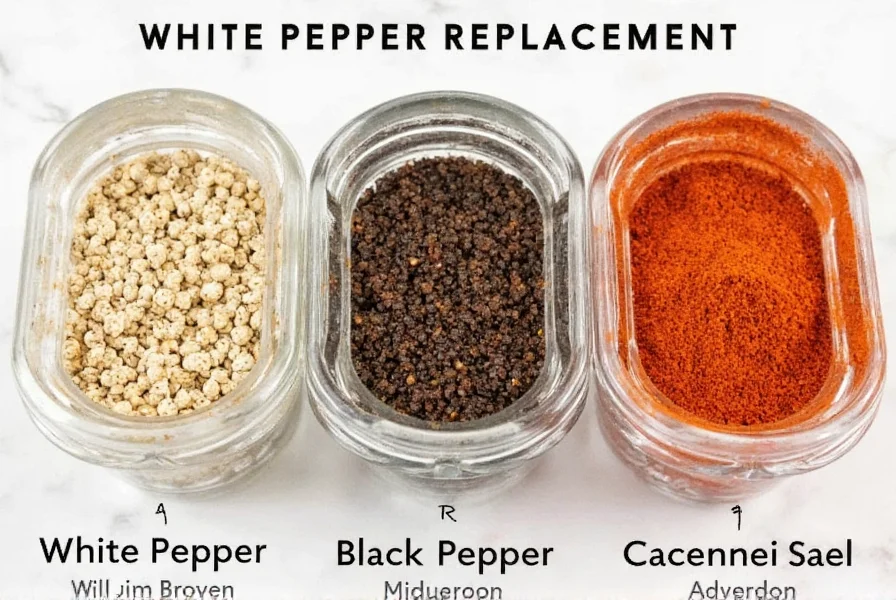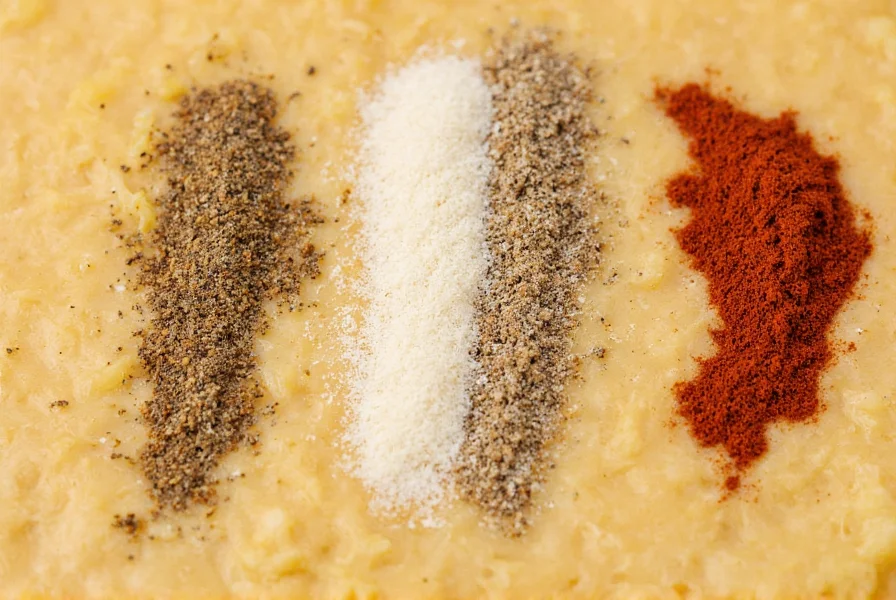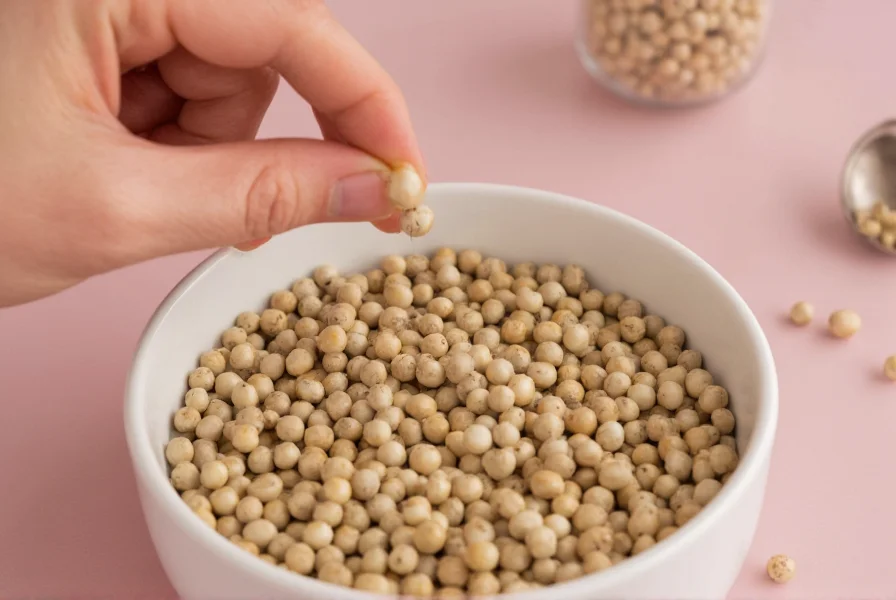White pepper offers a distinctive earthy, floral heat that's essential in many culinary applications, particularly light-colored sauces and dishes where black specks would be visually unappealing. When you find yourself without this specialty spice, knowing effective white pepper replacements ensures your recipes maintain their intended flavor profile without compromising presentation.
Understanding White Pepper's Unique Characteristics
Unlike black pepper, which comes from unripe peppercorns, white pepper is produced from ripe peppercorns with the outer layer removed through soaking and fermentation. This process creates a smoother, less citrusy heat that blends seamlessly into delicate dishes. Professional chefs often prefer white pepper in creamy soups, béchamel sauces, and mashed potatoes where visual purity matters.

Top 5 White Pepper Substitutes Ranked by Effectiveness
| Substitute | Ratio | Best For | Flavor Notes |
|---|---|---|---|
| Freshly ground black pepper | 1:1 | Most savory dishes | More citrusy, adds visible specks |
| Cayenne pepper | 1/8 tsp = 1 tsp white pepper | Asian cuisine, spicy applications | Direct heat without floral notes |
| Allspice | 1/4 tsp = 1 tsp white pepper | Creamy sauces, light soups | Warm, complex flavor profile |
| Black pepper + nutmeg | 3/4 black pepper + pinch nutmeg | Alfredo, béchamel | Mimics floral notes |
| Coriander powder | 1:1 | Light-colored stews | Citrusy, less pungent |
When Black Pepper Works as a White Pepper Replacement
For most savory applications outside of visually sensitive dishes, freshly ground black pepper serves as the most practical white pepper substitute. The key difference lies in visual presentation rather than dramatic flavor variation. When substituting black pepper for white pepper in recipes:
- Maintain a 1:1 ratio for equivalent heat levels
- Grind pepper immediately before use for maximum flavor
- Consider sifting ground pepper through a fine mesh to reduce visible specks
- Use in heartier dishes like gravies, stews, and meat rubs where appearance matters less
This substitution works particularly well for white pepper replacement in Chinese cooking where the primary concern is heat rather than visual presentation. Many authentic Chinese restaurants actually use black pepper in dishes traditionally calling for white pepper due to its superior flavor complexity.
Specialized Substitutes for Light-Colored Dishes
When creating visually pristine dishes like white pepper substitute for light sauces or creamy soups, appearance becomes as important as flavor. In these cases:
- Allspice provides similar earthiness without discoloration (use 1/4 teaspoon allspice per teaspoon of white pepper)
- Cayenne pepper delivers clean heat (use sparingly - 1/8 teaspoon cayenne equals one teaspoon white pepper)
- Coriander powder offers mild citrus notes that complement rather than dominate
For the best replacement for white pepper in alfredo sauce, try a combination of 3/4 teaspoon black pepper with a pinch of freshly grated nutmeg. This blend mimics white pepper's floral notes while maintaining visual appeal in the creamy sauce.

When Not to Substitute White Pepper
Certain culinary applications genuinely require white pepper's specific characteristics. Avoid substitutions when:
- Preparing traditional French béchamel where visual purity is essential
- Cooking Vietnamese pho where white pepper's distinctive flavor is integral
- Creating professional-grade consommés where specks would ruin clarity
- Following authentic Chinese banquet dishes where white pepper is specified
Storage Tips for Pepper Alternatives
To maximize shelf life and flavor potency of your white pepper replacements:
- Store all ground spices in airtight containers away from light and heat
- Keep whole peppercorns rather than pre-ground for maximum freshness
- Label containers with purchase dates (pepper alternatives lose potency after 6-12 months)
- Freeze cayenne pepper in small portions to preserve heat intensity
Practical Application Guide
Understanding white pepper replacement ratios prevents over-seasoning. When substituting in specific dishes:
- Creamy soups: Use allspice at 1/4 strength of white pepper requirement
- Meat marinades: Black pepper works at equal ratio with no visual concerns
- Light-colored stir-fries: Cayenne provides heat without discoloration
- Seafood dishes: Coriander offers complementary citrus notes
For authentic results in substitute white pepper in Chinese cooking, consider using a small amount of Sichuan peppercorns (1/4 teaspoon) combined with regular black pepper to approximate white pepper's unique floral heat without the visual distraction.
Frequently Asked Questions
Can I use black pepper instead of white pepper in mashed potatoes?
Yes, you can substitute black pepper for white pepper in mashed potatoes at a 1:1 ratio. While traditional recipes call for white pepper to maintain visual purity, black pepper provides superior flavor complexity. For the best results, use freshly ground black pepper and consider sifting it through a fine mesh strainer to reduce visible specks while preserving flavor.
What's the best white pepper substitute for alfredo sauce?
The best white pepper replacement for alfredo sauce is a combination of 3/4 teaspoon freshly ground black pepper with a pinch of freshly grated nutmeg per teaspoon of white pepper called for in the recipe. This blend mimics white pepper's floral notes while maintaining the sauce's visual appeal. Alternatively, allspice at 1/4 strength (1/4 tsp allspice = 1 tsp white pepper) works well for those seeking a single-ingredient substitute.
How much cayenne equals one teaspoon of white pepper?
Use 1/8 teaspoon of cayenne pepper to replace one teaspoon of white pepper. Cayenne delivers direct heat without white pepper's floral notes, so this substitution works best in spicy applications or Asian cuisine where additional heat is desirable. Always start with less cayenne than you think you need, as its heat builds gradually and can easily overpower a dish.
Does white pepper taste different from black pepper?
Yes, white pepper has a smoother, earthier, and slightly floral heat compared to black pepper's more citrusy, complex flavor with sharper pungency. The difference comes from processing - white pepper is made from ripe peppercorns with the outer layer removed, while black pepper uses unripe peppercorns dried with their outer layer intact. In blind taste tests, experienced chefs can distinguish the two, though the difference becomes less noticeable when incorporated into complex dishes.
Can I make my own white pepper substitute?
Yes, you can create an effective white pepper alternative by combining 3/4 teaspoon freshly ground black pepper with a pinch of nutmeg and a tiny pinch of coriander powder. This blend approximates white pepper's earthy, floral notes while minimizing visible specks. For immediate use, steep 1 teaspoon of black peppercorns in 2 tablespoons of hot water for 5 minutes, then strain - this creates a pepper infusion that provides heat without visible particles.











 浙公网安备
33010002000092号
浙公网安备
33010002000092号 浙B2-20120091-4
浙B2-20120091-4